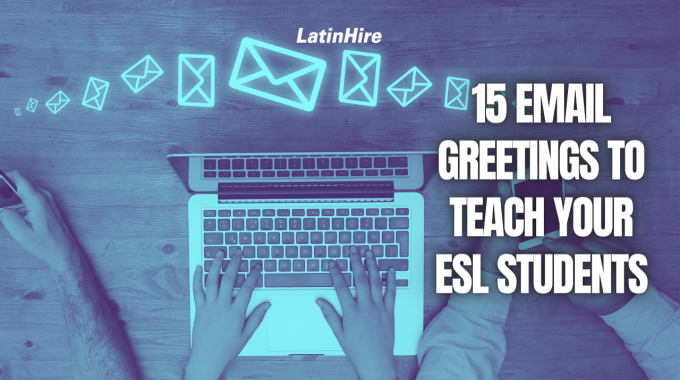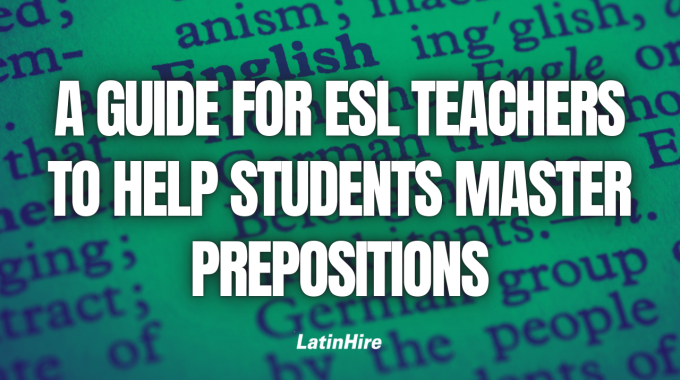Prepositions are some of the most commonly used words in the English language, but also…

15 Email Greetings to Teach Your ESL Students
Writing an email is an essential skill in communication, especially in professional settings. Teaching your ESL students how to write an email can do wonders for their careers and professional life.
This article will cover 15 formal and informal email greetings as there are a variety of ways you can start off an email depending on who the recipient is.
Let’s get started!
Formal Email Greetings

Formal email greetings are used with people you’re less familiar with or have a formal relationship with. For example, you can use these with your boss, service providers or human resources at a new job you want to apply to.
1) Dear [name]
This is a friendly way to start an email and it comes from the olden days of letter writing. It’s an endearing way to greet someone and it gives your email a warm start.
2) Greetings [name]
Using “Greetings” as an email opening can be a little robotic, but it’s perfectly acceptable. Better use this when you are introducing yourself for the first time or reaching out to someone you haven’t talked to in a while.
3) To whom it may concern
If you need to write a formal email, but you are not sure who is on the receiving end, you can start with this opening. This is generally used when emailing human resources or other genetic emails.
4) Good morning/afternoon/evening [name]
To start off your emails warmly, you can greet the receiver with a “good morning”, “good afternoon” or “good evening”. This is a quick greeting that will let you jump right into your point in the next sentence.
5) Hello [name]
A classic “Hello” can be used as a greeting in any situation. It’s a bit more formal than just a “Hi” or “Hey” and gives off a friendly vibe.
Following the Initial Greeting
After you make a formal initial greeting, it is always polite to follow up with a phrase to wish the receiver well or to introduce yourself before you jump into the topic of conversation. You can use any of the following phrases to make your emails better received.
6) I hope this email finds you well.
Well wishes are always welcome, so starting off with this phrase automatically makes the rest of your email seen in a better light. This phrase is vague enough that you don’t need to know the recipient at all.
7) Allow me to introduce myself.
If you have never made contact with the recipient, it is a good idea to introduce yourself first before moving on to further topics. This softens the request(s) that follows.
8) I’m reaching out to you because…
It’s always a good idea to let the receiver know why you are writing to them. There’s no need to beat around the bush. The clearer you are, the less you waste their time. Most professionals appreciate conciseness.
9) I hope your week is going well. / I hope you had a nice weekend.
This softens the email from the start and is less intrusive than starting with a question. You can also use variations of this such as, “I hope your family is well” or “I hope the kids are well.”
10) It’s my pleasure to inform you…
If you have good news to share with the recipient, you can use this phrase after the greeting. It’s polite and formal and lets them know that you want to tell them something good.
Informal Email Greetings

If you’re writing a casual email to a friend or colleague or even to your boss (depending on your relationship), you can use the following informal email greetings. Informal emails usually do not require a follow up phrase of well wishes, but you can still use phrases 5-10 above.
11) Hi/Hey [name]
Short, sweet and to the point, these email greetings can be a friendly way to start your message. Depending on your relationship, you may want to use their first name or last name followed by Mr./Mrs./Ms.
12) Hi, how’s it going?
This is very informal and is usually used among friends or colleagues. If you want to send a quick email to someone to make a request or to inform them about something, you can start this way.
13) Hey, how was the [event]?
If you know about an event the receiver has recently attended, you can start off your email with this question. For example, “How was your trip?” or “How was the conference?” This shows that you remember some details from your previous interactions.
14) Hello, my friend.
With someone you’re very familiar or friendly with, you can start off with this greeting. It may be seen as lazy if you don’t put their name, but it depends on the relationship that you have with the receiver. A simple greeting like this can be easily followed up with your request.
15) I was just thinking about you.
You can use this opening in emails where you want to reconnect with someone you have not spoken with in a while or if you just wanted to reach out and see how they’re doing. It makes people feel special when you express that you have them in mind.
We hope you enjoyed these email greetings and found them useful to teach your ESL students! What other email greetings do you use in formal and informal settings? Share them with us in the comments below!



